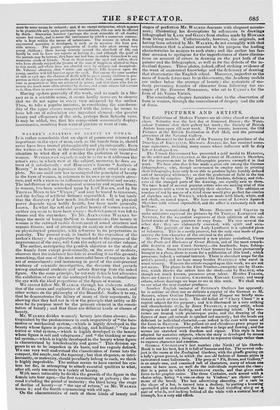WALKER'S ANALYSIS OF BEAUTY IN WOMAN.
IT is rather remarkable that an object of paramount interest and importance in the eyes of man, such as the female form is, should never have been treated philosophically and physiologically. Even the writers on beauty in the abstract have paid a very superficial attention to what they all ccnsider the perfection of beaut y- -woman. WINKELMAN regards it on3y in so far as it addresses the artist's eye; in which view of the subject, moreover, he does no treat of it satisfactorily : and HocAItru s famous "Analysis of Beauty" is merely an ingenious theory, neither sound nor com- plete. No one until now has investigated the principles of beauty in the form of woman, in reference to its uses as an organic struc- ture, and with a view to its influence on the individual and society. The indifference of men to corporeal symmetry and organic fitness in woman, has been remarked upon by Lord BACON, and by Sir THOMAS MoRE in his " Utopia ;" and may be traced to ignorance, and the feeling of artificial delicacy superadded. It is but lately that the discovery of how much intellectual as well as physical power depends upon bodily health, has been made generally known. In what the real and perfect beauty of woman consists, neither sex seem to have been aware : its development was left to chance and the staymaker. To Mr. ALEXANDER WALKER be- longs the merit of being the•first to demonstrate, that beauty in %Ionian is the outward visible denotement of sound structure and organic fitness; and of attempting its analysis and classification on physiological principles, with reference to its perpetuation in posterity. The present work is limited to the exposition of the author's theory : its application by mankind to the purpose of the improvement of the race, will form the subject of another volume.
The author, anticipating the prudish objection to the study of the female form except professionally, on the score of modesty, observes that the indelicacy has lain in avoiding it on this ground; remarking, that one of the most successful lures of coquetry is the art of concealment ; and instancing in proof of the anti-prurient tendency of scientific investigation, the decorum that prevails among anatomical students and artists drawing from the naked figure. On the same principle, he not only defends but advocates the exhibition of casts of the undraped female form, to familiarize the eye with the ideal proportions of the figure of woman.
We cannot follow Mr. WALKER through his elaborate refuta- tion of the errors and sophistries of BURKE, PAYNE KNIGHT, and other writers on the philosophy of the Beautiful. Suffice it to say, that he demonstrates the fallacy of many of their arguments, by showing that they had not in view the principle that utility or fit- ness for its purpose must be the primary element in the consti- tution of beauty ; and that there are different kinds or classes of beauty.
Mr. WALKER divides womanly beauty into three classes; dis- tinguished by the predominance in each respectively of "the loco- motive or mechanical system,—which is highly developed in the beauty whose figure is precise, striking, and brilliant ;" "the nu- tritive or vital system,—which is highly developed in the beauty whose figure is soft and voluptuous ;" and " the thinking or men- rtal system,—which is highly developed in the beauty whose figure is characterized by intellectuality and grace." This division ap- pears to us to be imperfect in its basis, and too vaguely defined. We can very well understand the classification of forms into the compact, the ample, and the tapering ; but that elegance, or intel- lectuality, or maternity, should peculiarly belong to each, we think is highly improbable. The author seems to have carried his sys- tem too far, in attempting to attach essential qualities to what, after all, only amounts to a variety of beauty. With more rationality he divides the growth of the figure in the female into four ages,—the first terminating at puberty; the se- cond including the period of maturity; the third being the stage of decline of beauty—or " the age of return," as Mr. WALKER terms it; and the fourth commencing with old age.
On the characteristics of each of these kinds of beauty and
stages of perfection Mr. WALKER descants with eloquent minute- ness ; illustrating his descriptions by references to drawings lithographed by LANE and GAIT' from studies made by HowAan from living models. Unfortunately, however, the originals, not having been selected by Mr. WALKER, do not exemplify with that completeness that is almost essential to his purpose the leading characteristics he assigns to each state; and the author has fur• ther occasion to apologize for the imperfectness of these illustra- tions on account of errors in drawing on the part both of the painter and the lithographer, as well as for the defects of the in- dividual figures. These plates, indeed, afford striking evidence of the want of anatomical knowledge and the deficiency of drawing that characterize the English school. Moreover, imperfect as the mass of female forms may be in this country, the Academy models are rather below the average of beauty ; the restraints of mo- desty preventing females of character front following the ex- ample of the Princess BORGUESE, who sat to CANOVA for the form of his Venus Victrix.
The concluding chapter furnishes a clue to the observation of form in woman, through the concealment of drapery and the aids of dress.


























 Previous page
Previous page